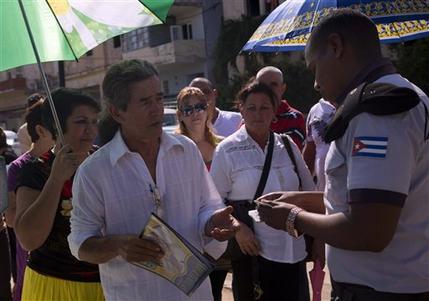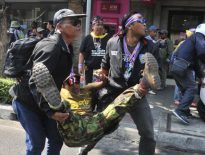HAVANA (AP) — Last February, Amalia Reigosa Blanco experienced for the first time the rush of an airplane taking off. She browsed the clothing shops of Italy’s fashion capital, and strolled cobblestone streets echoing with an unfamiliar tongue. She learned what snow feels like.

And then she came home.
I hope I can go on vacation again, said the 19-year-old language student, breaking into a broad smile as she recalled her first trip overseas, to visit family in Milan. “I’d love to see Paris.”
Reigosa was one of the first Cubans to take advantage of a travel reform that went into effect a year ago this week, when the government scrapped an exit visa requirement that for five decades had made it difficult for most islanders to go abroad. The much-hated measure was long justified as necessary to prevent brain drain as scientists, doctors, athletes and other skilled citizens were lured away from the Communist-run nation by the promise of capitalist riches.
A year into the new law, Cubans are traveling in record numbers. Some have not returned, but there’s no sign of the mass exodus that some feared. Dissidents are coming and going and raising their international profiles – and money – but there has been little impact on their limited ability to effect political change back home.
“I’m sure there was internal resistance to the migratory reform. I know that in some cases there were ministries that said `all our doctors are going to leave,’ and I can imagine some people in the ideological apparatus saying `if we let the dissidents travel, this is going to be terrible,'” said Carlos Alzugaray, a longtime Cuban diplomat and prominent intellectual.
“What has life shown?” he asked. “They did the reform, and nothing happened.”
Through the end of November, 185,000 Cubans traveled abroad on 258,000 separate trips, a migration official said last month. That represents a 35 percent increase on the previous year.
About 66,000 Cubans traveled to the U.S. during the period, a figure that apparently includes everyone from tourists to islanders with immigrant visas, from researchers on academic exchanges to dual Spanish-Cuban citizens who can enter the U.S. without a visa.
Ania Roman, a 46-year-old cosmetics shop worker, went to Miami in March, but even the clean, quiet streets of the neighborhood where her brother lives weren’t temptation enough to remain.
“Why didn’t I stay?” Roman shrugged. “Well, simply because I have my 68-year-old mother here and my children … and I’m not going to leave them.”
Only about 40 percent, or 26,000, have returned to the island so far. That means about 40,000 Cubans are still abroad – comparable to the total number of Cuban immigrants to the United States in 2012.
There is no way of knowing their plans, but many are likely to return to the island eventually, after finishing up the academic year, for example, or taking advantage of a new provision in the travel reform that lets islanders stay overseas for two years without losing residency rights back home.
Cubans who remain in the U.S. for at least a year qualify for residency there, meaning for the first time some will be able to live binational lives, shuttling back and forth and enjoying the best of both countries.
There are still barriers to travel, such as affording the cost of airfare and the difficulty of obtaining visas from countries that view Cubans as possible immigrants.
But it seems inevitable that the law will lead to some increased emigration, at least as long as Cuba’s economy remains so weak. Others will leave to escape Communism, though more recent emigrants have tended to leave more often for financial opportunity than for political freedom.
It would be a continuation of an upward trend in recent years that in 2012, before the reform took place, saw 46,662 islanders leave legally and permanently, according to Cuban government statistics. That was the largest outflow since 1994, but far less than past migratory crises such as the 1980 Mariel Boatlift, when some 125,000 left in a span of six months.
There have also been anecdotal reports of doctors defecting, and more Cubans showing up at the U.S.-Mexico border and claiming entry under a law that lets Cubans who arrive on U.S. soil stay. Visa requests are up at the Mexican Embassy in Havana, which recently had no visa appointments available until 2016.
Last week six Cubans were temporarily in limbo at the transit area of the international airport in Bogota, Colombia, after they were kicked out of Ecuador and refused to board their connecting flight back to Havana.
Ecuador is one of the few nations that don’t require a visa of Cubans, but after the January law it began making them secure letters of invitation to enter.
The U.S., meanwhile, has publicly welcomed the travel reform and issued around 32,000 tourist and professional visas to Cubans in the most recent fiscal year ending Sept. 30 – a 100 percent increase over the previous period – according to the U.S. Interests Section in Havana. The mission, which Washington maintains instead of an embassy, also handed out roughly 24,000 immigration visas.
Havana is betting that those who leave will send even more money back home than they do now. Remittances rose slowly during the George W. Bush administration and skyrocketed after President Barack Obama lifted limits on how much Cubans in the United States can send home each year. Overall, they are up more than 160 percent since 2000, according to a study by economist Emilio Morales of the U.S.-based Havana Consulting Group.
Morales estimates that remittances were $5.1 billion in 2012, about half of that in cash and half “in kind” – goods sent or brought to the island. Only Cuba’s oil-and-services commercial deals with Venezuela represent a bigger source of foreign income.
As for the dissidents, many have gone overseas to claim international human rights prizes and publicly bash President Raul Castro’s government. Only those with pending legal cases have been denied a passport.
“We have been able to go to places where there is freedom, where there is democracy,” said Berta Soler, a leader of the Ladies in White protest group who shook Obama’s hand in Florida in November. “We have been able to talk to the international community about the reality of the Cuban people.”
Yet they face an uphill climb to raise their profile back home, where they are largely unknown and ignored by state-run media. Some have stayed overseas, eliminating a headache for a government that officially considers the opposition mercenaries out to undermine its sovereignty.
Travel can help the dissidents “in terms of a boomerang, them having international exposure and that getting back to Cuba,” said Ted Henken, a professor at Baruch College who studies the dissidents and has ties to some. “But to the extent that they need to engage the public in Cuba … there’s still a brick wall in terms of control of the mass media and public spaces.”
—
Associated Press writer Anne-Marie Garcia in Havana contributed.





